Regulation of p73 by Hck through kinase-dependent and independent mechanisms
- PMID: 17535448
- PMCID: PMC1899183
- DOI: 10.1186/1471-2199-8-45
Regulation of p73 by Hck through kinase-dependent and independent mechanisms
Abstract
Background: p73, a p53 family member is a transcription factor that plays a role in cell cycle, differentiation and apoptosis. p73 is regulated through post translational modifications and protein interactions. c-Abl is the only known tyrosine kinase that phosphorylates and activates p73. Here we have analyzed the role of Src family kinases, which are involved in diverse signaling pathways, in regulating p73.
Results: Exogenously expressed as well as cellular Hck and p73 interact in vivo. In vitro binding assays show that SH3 domain of Hck interacts with p73. Co-expression of p73 with Hck or c-Src in mammalian cells resulted in tyrosine phosphorylation of p73. Using site directed mutational analysis, we determined that Tyr-28 was the major site of phosphorylation by Hck and c-Src, unlike c-Abl which phosphorylates Tyr-99. In a kinase dependent manner, Hck co-expression resulted in stabilization of p73 protein in the cytoplasm. Activation of Hck in HL-60 cells resulted in tyrosine phosphorylation of endogenous p73. Both exogenous and endogenous Hck localize to the nuclear as well as cytoplasmic compartment, just as does p73. Ectopically expressed Hck repressed the transcriptional activity of p73 as determined by promoter assays and semi-quantitative RT-PCR analysis of the p73 target, Ipaf and MDM2. SH3 domain- dependent function of Hck was required for its effect on p73 activity, which was also reflected in its ability to inhibit p73-mediated apoptosis. We also show that Hck interacts with Yes associated protein (YAP), a transcriptional co-activator of p73, and shRNA mediated knockdown of YAP protein reduces p73 induced Ipaf promoter activation.
Conclusion: We have identified p73 as a novel substrate and interacting partner of Hck and show that it regulates p73 through mechanisms that are dependent on either catalytic activity or protein interaction domains. Hck-SH3 domain-mediated interactions play an important role in the inhibition of p73-dependent transcriptional activation of a target gene, Ipaf, as well as apoptosis.
Figures


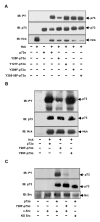
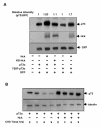

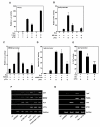

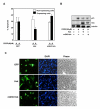
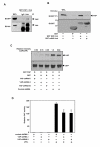
Similar articles
-
Inhibitory role of Plk1 in the regulation of p73-dependent apoptosis through physical interaction and phosphorylation.J Biol Chem. 2008 Mar 28;283(13):8555-63. doi: 10.1074/jbc.M710608200. Epub 2008 Jan 3. J Biol Chem. 2008. PMID: 18174154 Free PMC article.
-
Activation of STAT3 by the Src family kinase Hck requires a functional SH3 domain.J Biol Chem. 2002 Nov 22;277(47):45680-7. doi: 10.1074/jbc.M204255200. Epub 2002 Sep 19. J Biol Chem. 2002. PMID: 12244095
-
Phosphorylation-dependent interactions between ADAM15 cytoplasmic domain and Src family protein-tyrosine kinases.J Biol Chem. 2002 Feb 15;277(7):4999-5007. doi: 10.1074/jbc.M107430200. Epub 2001 Dec 10. J Biol Chem. 2002. PMID: 11741929
-
Regulation of p73 activity by post-translational modifications.Cell Death Dis. 2012 Mar 15;3(3):e285. doi: 10.1038/cddis.2012.27. Cell Death Dis. 2012. PMID: 22419114 Free PMC article. Review.
-
Regulation of the p73 protein stability and degradation.Biochem Biophys Res Commun. 2005 Jun 10;331(3):707-12. doi: 10.1016/j.bbrc.2005.03.158. Biochem Biophys Res Commun. 2005. PMID: 15865926 Review.
Cited by
-
CREB, a possible upstream regulator of Bcl-2 in trichosanthin-induced HeLa cell apoptosis.Mol Biol Rep. 2010 Apr;37(4):1891-6. doi: 10.1007/s11033-009-9629-9. Epub 2009 Jul 21. Mol Biol Rep. 2010. PMID: 19626458
-
Src family kinases promote silencing of ATR-Chk1 signaling in termination of DNA damage checkpoint.J Biol Chem. 2014 May 2;289(18):12313-29. doi: 10.1074/jbc.M113.533752. Epub 2014 Mar 14. J Biol Chem. 2014. PMID: 24634213 Free PMC article.
-
A positive feedback loop between Gli1 and tyrosine kinase Hck amplifies shh signaling activities in medulloblastoma.Oncogenesis. 2015 Nov 30;4(11):e176. doi: 10.1038/oncsis.2015.38. Oncogenesis. 2015. PMID: 26619401 Free PMC article.
-
Molecular basis of the interactions between the p73 N terminus and p300: effects on transactivation and modulation by phosphorylation.Proc Natl Acad Sci U S A. 2009 Mar 3;106(9):3142-7. doi: 10.1073/pnas.0900383106. Epub 2009 Feb 13. Proc Natl Acad Sci U S A. 2009. PMID: 19218448 Free PMC article.
-
Analysis of the intracellular localization of p73 N-terminal protein isoforms TAp73 and ∆Np73 in medulloblastoma cell lines.J Mol Histol. 2010 Oct;41(4-5):267-75. doi: 10.1007/s10735-010-9288-0. Epub 2010 Aug 28. J Mol Histol. 2010. PMID: 20803057
References
-
- Kaghad M, Bonnet H, Yang A, Creancier L, Biscan JC, Valent A, Minty A, Chalon P, Lelias JM, Dumont X, et al. Monoallelically expressed gene related to p53 at 1p36, a region frequently deleted in neuroblastoma and other human cancers. Cell. 1997;90:809–819. doi: 10.1016/S0092-8674(00)80540-1. - DOI - PubMed
Publication types
MeSH terms
Substances
LinkOut - more resources
Full Text Sources
Other Literature Sources
Molecular Biology Databases
Research Materials
Miscellaneous

